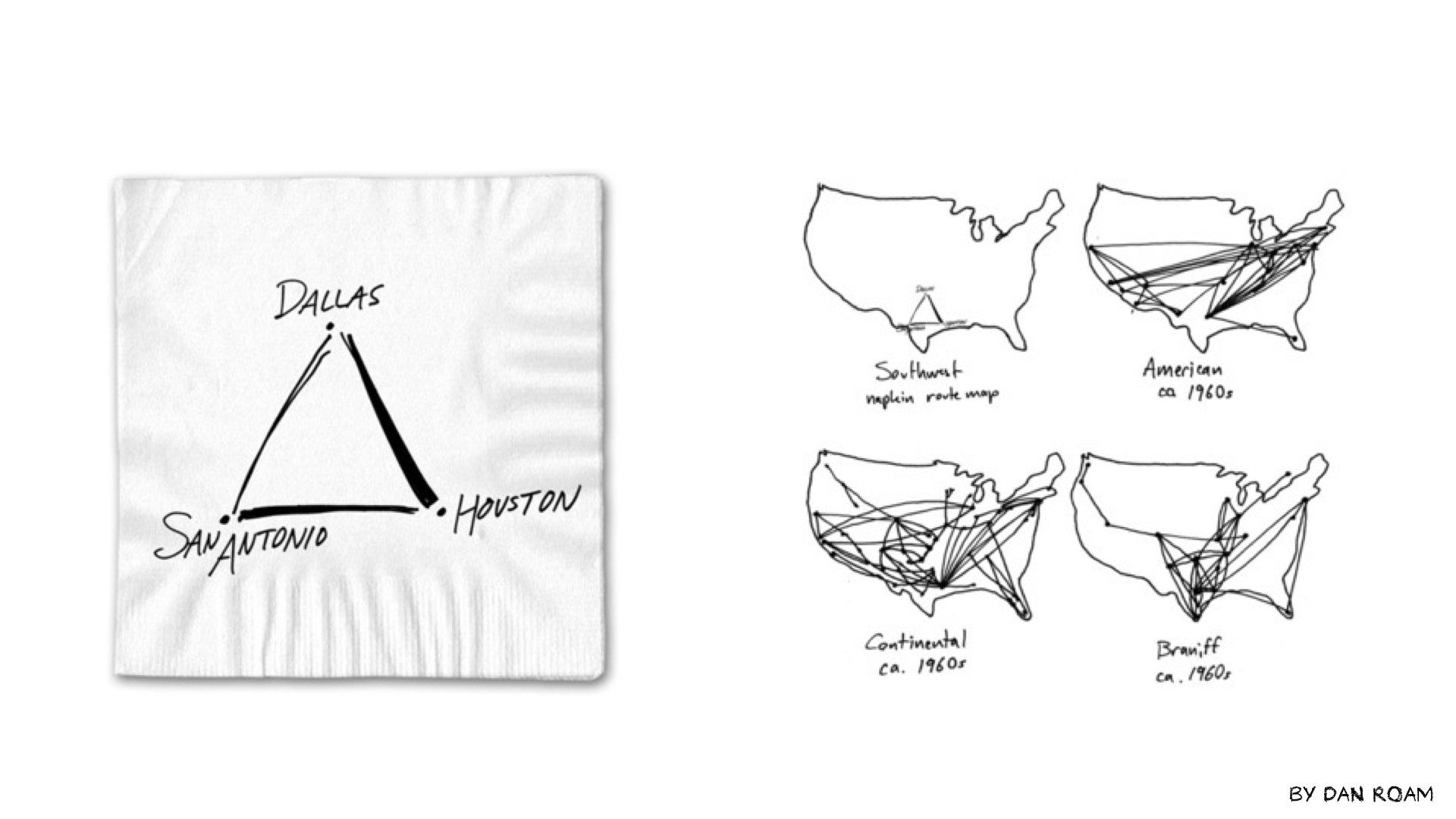Early in my career, I had the good fortune of getting a crash course in the power of visual thinking. While many have been in the know about this critical tool for leadership and selling ideas, it took me a long time to connect the dots and use it effectively in my work. Here is a little backstory about my journey, some actionable takeaways, and resources to take your visual thinking and leadership to the next level.
The napkin and the pen

Credit: Dan Roam
Where my journey started
When I turned 22 I lost my job when the tech bubble burst in 2001. I had graduated from Florida State with an English degree and took a job with a startup as an SDR (Sales Development Rep) making 100 cold calls a day. It sucked, and then the company went under. I spent the next two months wandering. I took a three-week sabbatical that included two trips to Key West (from my home base on South Florida). I then took a job selling advertising door to door in Broward and Dade Counties. I’m pretty sure it was a front for the mob, it didn’t last more than 3 weeks.
I had a taste of marketing at the startup I worked at, and I liked what I saw. Little did I know how little sophistication there was in our so-called “marketing”, truthfully, I didn’t have a clue what marketing really was. Nevertheless, now out of work, I called my friend Chris. I knew his Dad, owned a marketing firm in the area. I thought maybe he could point me in the right direction. He called me back 15 mins later with a phone number, his Dad was waiting for my call. I was shocked and a little intimidated.
A new world opens
“Son, why don’t you come down to the office around 3:30 tomorrow afternoon.” Oran talked like that. He grew up in Tennessee, married his high school sweetheart, and played football at Alabama for Bear Bryant. He’s made of different stuff.
So I went, and he graciously invited me to sit in on a meeting. I sat there for 90 mins, while people talked circles around me about SQL databases, massive mailing campaigns, integrated email campaigns, SKU tracking for results to measure ROI. Was this marketing? What were they talking about?
He invited me back to his office and he asked me if I understood anything in the meeting. I politely explained that I hadn’t a clue, and I was quietly wondering why I was still there. He offered me a job. I was dumbfounded, but I needed an opportunity. He offered me $25,000 a year to start. The more I learned, the more I’d earn. I got to work with AT&T, Guitar Center, Royal Caribbean, and other brands. It was the best career pivot I ever made.
I spent the next year learning the ins and outs of data-driven, direct response marketing. I learned it by sitting in Oran’s office for hours on end, listening to calls with clients and consultants, talking about elaborate direct mail and email campaigns powered by complex SQL databases, measured and reinforced by purchase data.
Often, after a long strategy call, he’d ask if I could playback what I had heard, if I struggled he’d say ‘draw a picture, son’. I’ve never been able to shake those words. I can still hear his matter-of-fact, Tennessee drawl. By ‘draw a picture’ he meant putting pencil to a piece of graph paper. Draw flow charts or a mind map to clarify the operational design of the campaign. I’d look around his office and he had pieces of graph paper everywhere. On the walls, on the floor…everywhere. To this day those words bounce around my head every time I need to solve a problem, I hear Oran saying ‘Draw a picture, son’.
Fast forward almost 20 years and it’s one of the most useful professional tools I have. My teams regularly give me shit for my inability to avoid whiteboards when leading a discussion. Now, I’m leading a global marketing team that is completely remote and I find myself surrounded by pads of graph paper, pencils, stencils, and other tools to bring my visual thinking to life. I haven’t quite found the right tool to make it happen more spontaneously in collaboration. I’m mostly relegated to slides.

Pictures are the language of our paleolithic ancestors, it’s where it all started. It’s how humans have communicated since we’ve been capable of doing so. Stories live in the art and pictures we’ve drawn throughout history. It stands to reason that we’re wired for visual learning. Pictures have always been there.
Takeaways
- When you’re struggling with a concept or problem, stop, take out a pencil and paper and draw a picture.
- Visual thinking and communication are key capabilities for any leader. A simple picture, even a basic drawing will make any message more impactful
- Two concepts are helpful in understanding why visuals are important:
- Picture Superiority Effect (PSE): Simply put, when it comes to comprehension and retention, using images is far better than text alone.
- Dual Coding: Combining factual information and add visuals, it engages both the left (analytical) and right (abstract), sides of the brain.
Google them
Resources:
Here are a few resources that I find helpful in developing as a visual leader.
- Dan Roam: Back of the Napkin and Draw to Win
- Todd Cherches: VisuaLeadership
- Nancy Durate: Slide:ology: The Art and Science of Creating Great Presentations.
- Ted Talk: Todd Cherches – The power of visual thinking
- Ted Talk: Garr Reynolds – Story, Imagery, and the Art of the 21st Century Presentation
